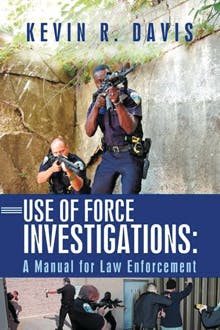Use Of Force Investigations - A Book Review
Kevin R. Davis has written a must-have manual for anyone involved in use of force investigations. As a full-time police officer with more than thirty years experience, Kevin has the credentials needed to author an instructive book on a subject that is often times handled improperly. Moreover, Kevin knows the subject matter intimately, having been personally involved in it not only as a cop, but he has testified in court as a subject matter expert.
Use Of Force Investigations: A Manual for Law Enforcement, is a pragmatic, concise, common sense guide to handling everything from hands-on confrontations to officer involved shootings. The book is a comprehensive manual on the legal and practical aspects of police use of force investigations. It is designed for street officers, front-line supervisors, investigators, attorneys, police unions and agency administrators.
Suitable for basic academy and in-service training, the manual contains information on constitutional parameters, teaching use of force, agency policy, street application, reporting and investigating incidents involving the use of deadly or non-deadly force by police officers in the United States.
Kevin doesn’t pull any punches in this instructive tome. I particularly enjoyed his take on comments made by supervisors that involve “how an incident looks to the public.” The author is quick to point out that whether or not punching someone looks bad to the public, or perhaps to the chief, the standard for use of force is not what looks good or not. If an officer takes time to decide whether his actions will “look bad,” he wastes valuable response time and can easily get hurt or killed.
Of particular relevance in our ever-advancing technological society, is the use of video in determining right or wrong. “Use of force is like making sausage. Even when it’s done properly, it still doesn’t look good.” This quote from Ed Nowicki, a retired Chicago cop and well-respected trainer and founder of ILEETA, puts video in perspective. What we see, or what the public sees, is often not the whole story and can distort the facts. Video footage that “looks bad” may in fact be completely reasonable.
Davis quotes Dr. Bill Lewinski, Force Science Institute, regarding video tapes of police for investigating cases involving the use of force: “People tend to think that a video is an accurate reporter of any particular incident. But . . . look at the number of cameras that are necessary for referees to look at any football game. So we know that one video camera from a particular perspective is very limiting in its ability to see anything.”
Davis’ book also deals with media contact. He stresses that it is important to have a trained PIO (public information officer) to deal with inquiries. Refusing to comment about an incident can lead to more headaches. A simple statement such as, “The incident is still under investigation,” buys more time and consideration than a “no comment.” Another important reminder when dealing with the media: regardless of any relationship one may have built with a media type, there should never be a remark or answer given that is prefaced by, “this is off the record.”
Use Of Force Investigations is a treasure trove of case studies, techniques and misperceptions about things such as, “Can I shoot someone in the back?” The book cites and illustrates Supreme Court decisions such as Tennessee v. Garner (1985) and Graham v. Connor (1989). Davis points out the importance of teaching our officers about deadly force realities, rather than continuums, where tactics and techniques taught in the gym fall apart when faced on the street by a violent offender with nothing to lose.
Use Of Force Investigations as well as the books listed in the Appendix, should be on each investigator’s book shelf. It’s a must read.
Stay safe, Brothers and Sisters!
Links: http://www.amazon.com/Use-Force-Investigations-Manual-Enforcement/dp/1470500124

John Wills
John M. Wills is a former Chicago police officer and retired FBI agent. He is a freelance writer and award-winning author in a variety of genres, including novels, short stories and poetry. John also writes book reviews for the New York Journal of Books, and is a member of the National Book Critics Circle. His new book, The Year Without Christmas, is available now. Visit John at: www.johnmwills.com.



